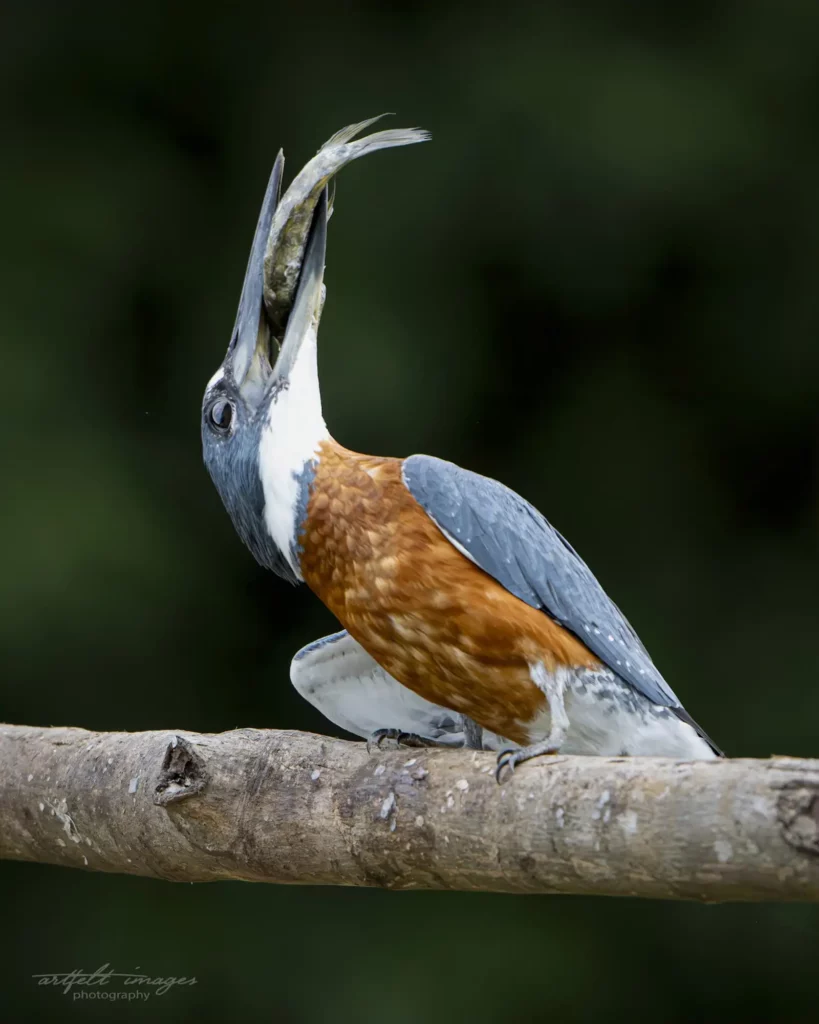Ringed Kingfisher
The Ringed Kingfisher’s powerful presence and distinctive hunting behavior make it a fascinating species to observe in the wetland and riverine environments of Costa Rica.

Megaceryle torquata
Scientific Name
Alcedinidae (Kingfishers)
Family
Coraciiformes
Order
Monotypic species, with no recognized subspecies.
Subspecies.
Range and Habitat of Ringed Kingfisher
Geographic Range
- Found from southern Texas and Mexico through Central America (including Costa Rica) and into much of South America, extending as far south as Argentina.
- In Costa Rica, it is commonly found near freshwater habitats, especially on both the Pacific and Caribbean slopes.
Migratory Patterns
Non-migratory, though it may move locally in search of better fishing grounds.
Preferred Habitat
Prefers freshwater environments, including rivers, lakes, marshes, and coastal estuaries.
Altitude Range
Primarily a lowland species, but can be found up to 1,500 meters (5,000 feet).
Costa Rica Habitat
In Costa Rica, it can be seen along slow-moving rivers and streams, wetlands, and mangroves.
Conservation Status
Least Concern
Conservation Status
Population Status
Stable, with a broad range across the Americas, and categorized as Least Concern by the IUCN.
Habitat destruction, particularly the loss of wetlands and pollution of water sources. Human disturbance near breeding sites, such as erosion of riverbanks.
Conservation efforts
Protected in several national parks and reserves in Costa Rica, where their habitat is preserved. Efforts to protect water quality in rivers and wetlands also benefit this species.
Primary Threats
Habitat destruction, particularly the loss of wetlands and pollution of water sources. Human disturbance near breeding sites, such as erosion of riverbanks.
Ringed Kingfisher Identification
How to Identify the Species
Rarity Level:
CommonBest Viewing Times:
Early Morning (Dawn - 8 AM)
Size
Length: 40-41 cm (16 inches) Wingspan: Approximately 56 cm (22 inches) Weight: 300-340 grams (10.6-12 oz)
Plumage
Adults have a slate-blue head and back, with a broad white collar around the neck. The chest is a rich rufous color, while the belly is white.
Distinctive Features
- Large, robust black bill and a broad body.
- The most distinguishing feature is the reddish or rust-colored chest band, from which the species gets its name.
Sexual Dimorphism
Females have a rufous breast and a bluish-gray band across the upper belly. Males have a more uniformly rufous underside, with no band.
Diet and Feeding Behavior
Primary Diet
- Primarily feeds on fish but will also eat crustaceans, amphibians, and occasionally small reptiles and insects.
Foraging Techniques
- Hunts by perching on a branch or hovering above water before diving to catch fish with its large bill. It can often be seen perching on exposed branches or wires near water.
Feeding Times
- Mostly diurnal, hunting throughout the day, with peak activity in the early morning and late afternoon.
Behavior Patterns
Ringed Kingfisher
Social Structure
Solitary, except during the breeding season. They are often seen alone or in pairs near their feeding grounds.
Song and Vocalization
A loud, rattling “kree-kree-kree” call is frequently heard, especially in flight. It is often vocal when flying between perches or when startled.
Courtship and Mating Ritual
Courtship involves vocal displays and aerial chases. The male may offer food to the female as part of pair bonding.
Territoriality
Highly territorial, especially during breeding season, defending its fishing spots and nesting sites from other kingfishers and birds.
Birdwatching Tips
Best Locations for Spotting Ringed Kingfisher
Tortuguero National Park, Palo Verde National Park, and Cano Negro Wildlife Refuge offer prime habitats for spotting Ringed Kingfishers. They can also be found along rivers and lakes in both lowland rainforests and more arid areas of Guanacaste.

Best Time of the Year
Year-round, but they are more active during the dry season when water levels are lower and prey is easier to catch.
Common Behavior
Look for them perched on branches overhanging water, where they often sit patiently before diving for fish. They are also highly vocal, so their rattling call is a helpful clue.
Recommended Gear
Binoculars for clear views of the kingfisher perched near water, and a camera with a fast shutter speed to capture its diving behavior.
Breeding and Nesting Behavior
Breeding Season
In Costa Rica, the breeding season typically occurs during the dry season, from January to April.
Nesting Sites
Nests are dug into the banks of rivers or lakes, creating a tunnel that leads to a chamber where eggs are laid.
Clutch Size
three to six eggs.
Incubation Period
Parental Care
Both parents are involved in feeding the young, which fledge after about four weeks.
Did You Know?
How do I identify this bird?
Look for a large kingfisher with a slate-blue back, white collar, and a rust-colored chest. The loud, rattling call is another good indicator of its presence.
Where is the best place to see it?
In Costa Rica, rivers, lakes, and wetlands in protected areas like Tortuguero or Palo Verde offer great opportunities to observe the Ringed Kingfisher.
Is this bird endangered?
No, it is currently classified as Least Concern, with a stable population across its wide range.